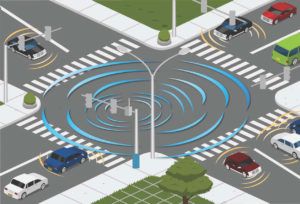Occasionally, change occurs so rapidly it seems the world is spinning faster than ever. Technology changes occurring in roadways and bridges today are amazing, to say the least. Motorists will soon experience roadway technology never imagined in the past. The transportation sector is definitely a change leader in the U.S.
Here are a few examples worthy of note.
The city of Phoenix now determines roadway needs and prioritizes street repair by using a specialized vehicle that relies on infrared and radar to identify cracks and roadways in need of repair. The van that tests and records these issues is equipped with sophisticated technology, including lasers and infrared cameras that scan the street, record abnormalities, and send the data to the city’s management system. Cost of the technology-enhanced van is about US$1 million. City officials in Phoenix plan to repair about 1,650 miles of roadway over the next five years.
Traffic incidents have been reduced by 30% on the Indiana Toll Road because of an’ intelligent transportation system’. The toll road has fiber-optic technology in place that monitors road and bridge temperatures, ice hazards, friction resistance, and interchange problems. This particular roadway with its technology stretches for 157 miles and is serviced by 22 toll plazas, five maintenance barns, and two administration buildings. Digital speed limit signs warn motorists of weather conditions while other signage focuses on wrong-way driver detection, designates smart truck parking systems, and alerts drivers about congestion to avoid.
 In San Antonio, the city and its municipal utility partnered to provide smart streetlights on certain roadways. The lights do more than illuminate city streets; they also sense flooding patterns, measure air quality, check temperatures, and provide information related to available parking spaces. This initial project has placed the technology-laden lights in the city’s designated ‘innovation zones’. Additional smart lighting will likely be procured if this initial project is as successful as anticipated.
In San Antonio, the city and its municipal utility partnered to provide smart streetlights on certain roadways. The lights do more than illuminate city streets; they also sense flooding patterns, measure air quality, check temperatures, and provide information related to available parking spaces. This initial project has placed the technology-laden lights in the city’s designated ‘innovation zones’. Additional smart lighting will likely be procured if this initial project is as successful as anticipated.
Transportation experts agree that wrong-way driver detection reduces traffic incidents significantly, but the advanced technology designed to protect motorists is not yet common on roadways. However, in January, 2019, the Nevada Department of Transportation (NDOT) placed new wrong-way driver detection systems on all freeway ramps on 395. In a pilot project, NDOT also added flashing warning signals to be tested in the North Valleys area. These systems use radar, closed-circuit cameras and other technology to detect vehicles entering a roadway in the wrong direction. Some have not only warning capabilities, they also have notification capabilities.
In Colorado, the DOT installed sensor technology on roadways to test the concept of “smart roads”. The sensors are designed to report important information to the agency. Information transmitted will be related to a vehicle’s weight and the speed and pattern of travel. It will be used for different purposes such as navigation, mapping, and planning, but another important benefit is that the monitoring system is linked to emergency operations. If and when an accident occurs, the sensors will immediately alert and direct first responders to the scene.
Significant emphasis has been placed on developing roadway technology to reduce accidents related to weather conditions such as snow and ice. Now, transportation sensors can autonomously melt ice and snow. The sensors gauge temperatures and, when necessary, turn on heat to correct hazardous roadway conditions. Even on old roads, the sensors can be inserted into slits and the technology can be activated. Canada and a few other countries are using this type of technology to make roads, parking lots, and other paved areas safer. Bridges and highway ramps also may be fitted for sensors.
 The University of California, San Diego found a way to use plastic bags as one of the ingredients in asphalt. The plastic bags, once designated as waste, could not be recycled so the objective was to find a way to make them useful. Now, several different municipalities as well as private companies are investigating this unique way to use plastic that otherwise creates a significant problem in the future.
The University of California, San Diego found a way to use plastic bags as one of the ingredients in asphalt. The plastic bags, once designated as waste, could not be recycled so the objective was to find a way to make them useful. Now, several different municipalities as well as private companies are investigating this unique way to use plastic that otherwise creates a significant problem in the future.
Florida’s Department of Transportation (FDOT) recently announced that a new wrong-way driver detection system is now functioning on Howard Frankland Bridge. This project was noteworthy because it was the first bridge in the Tampa Bay area to test the technology. The cameras in use are monitored at the state’s traffic management center, and when the system detects a car traveling the wrong direction, it sounds an alarm. FDOT is alerted immediately and messages appear on roadway boards. Additionally, patrol vehicles are dispatched to intercept the vehicle.
Roadways in America will definitely function differently in the future. Technology that allows a road to capture power from vehicle friction and move it into a grid is now possible. Electric vehicle charging stations are being deployed throughout the country. Connected transportation networks will become common; traffic lights will be coordinated and motorists will soon find messages of all types directed to them via digital signage. Such changes point to a transportation revolution resulting from the escalation of roadway technology.
Mary Scott Nabers is president and CEO of Strategic Partnerships Inc., a business development company specializing in government contracting and procurement consulting throughout the U.S. Her recently released book, Inside the Infrastructure Revolution: A Roadmap for Building America,is a handbook for contractors, investors and the public at large seeking to explore how public-private partnerships or joint ventures can help finance their infrastructure projects.






